
High Plains Gardening
The gardening website of the Texas High Plains Region
Landscapes designed and populated with Southwest native plants are in sharp contrast to the more foliage intense English, eastern, southern, Pacific northwest and northern areas. Typically, the evergreens in those landscapes feature shrubs with many needles or leaves. Overlooked evergreen plants of the southwest landscape are often a succulent, a plant with living tissue that is able to temporarily store water allowing it to be independent of another water source through periods of drought or low rainfall. Plants of a succulent nature are found in nearly every family; the whole of the plant need not be succulent for the plant to be considered a succulent. For instance, the roots, stems or leaves may b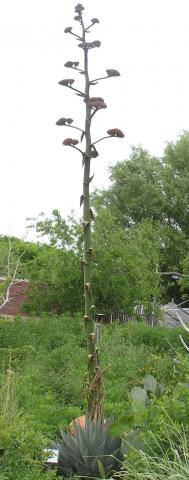 e the succulent feature. Examples of root succulence are tuberous roots, corms, rhizomes and bulbs.
e the succulent feature. Examples of root succulence are tuberous roots, corms, rhizomes and bulbs.
Our Southwestern evergreens include a selection of agaves, cacti, many yuccas and other non-native succulent plants (sedums) that thrive in the Texas Panhandle. Virtually untapped as a means of winter green and winter interest, our native evergreen (or ever-blue, ever-gray) succulents can easily be incorporated into native, low water-use, Western cottage and rock garden designs and styles. Agaves, yuccas and cacti were greatly prized and imported from the New World to the Old in the early days of North American exploration by the Europeans, having readily naturalized throughout the greater Mediterranean region. (Agave havardiana at left, A. neomexicana at right.)
In the Southwest, nearly nothing will make as dramatic a statement as one of the large mature agaves. Their imposing thick succulent leaves stare you down and dare one to come look closer. Who can ignore the Octopus agave, Agave vilmoriniana, (Photo at very bottom of page at the right) – its like a big monster waving it’s arms. Or the imposing giant agave, A. salmiana. But even smaller agaves provide interest, espe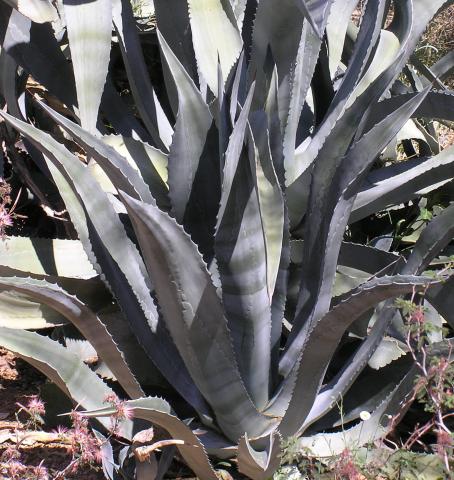 cially when in dramatic flower.
cially when in dramatic flower.
Agaves are native to the United States, Mexico, Central America, Venezuela, Columbia, Brazil and some islands in the West Indies. It is thought there are from 200 – 250 species within the genus Agave. Mexico is the center of diversity of agaves, claiming about 75% of the species. Approximately 15-18 species are native to the United States, eleven of these are said to be native in Texas (9-10 species I'm pretty sure are native to Texas: Agave havardiana, gracilipes, lechuguilla, lophantha (could be the same as A. univittata), parryi, parryi ssp. neomexicana, parryi ssp. Parryi, scabra (A. asperrima), univittata, the natural hybrid × glomeruliflora, USDA Plant Data Base).
Linnaeus first described the genus Agave, a Greek word meaning “noble”, in 1753. The regional name for agave is the Taino Spanish word maguey. Since 1866, there has been much shifting of genera into and out of the former Agavaceae family. Changes continue to occur to the former Agavaceae family. According to the latest classification system, Angiosperm Phylogeny Group III, or APG III, the former family of Agavaceae was reclassified to, Agavoideae, a subfamily of the Asparagaceae family in 2009. Today, the subfamily of Agavoideae consists of 29 genera, including Agave, Camassia, Furcraea, Hosta, Hesperaloe, Hesperoyucca, Manfreda, Polianthes and Yucca to name a few. It is speculated by some that agaves might have evolved from the hosta.
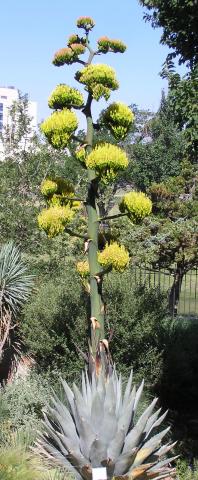 Agaves live many years and are considered to be perennials, but as they are monocarpic, (that is, they bloom only once and then die), they should be considered to be multiannuals. Agaves are succulent, rather than herbaceous, trunkless and unbranched plants shrubs. Agave leaves are arranged in a spiral along a small, often undetectable stem, which forms a rosette. Rosettes are an adaption in arid regions where the leaves funnel water to the root zone. During times of extreme drought, the stem will shrink, creating a tiny separation between the stem and soil for water to drain to the roots when rainfall finally occurs. In addition to being succulent, many species have leaves coated with a waxy cuticle to prevent transporation. (Photo of A. havardiana at left.)
Agaves live many years and are considered to be perennials, but as they are monocarpic, (that is, they bloom only once and then die), they should be considered to be multiannuals. Agaves are succulent, rather than herbaceous, trunkless and unbranched plants shrubs. Agave leaves are arranged in a spiral along a small, often undetectable stem, which forms a rosette. Rosettes are an adaption in arid regions where the leaves funnel water to the root zone. During times of extreme drought, the stem will shrink, creating a tiny separation between the stem and soil for water to drain to the roots when rainfall finally occurs. In addition to being succulent, many species have leaves coated with a waxy cuticle to prevent transporation. (Photo of A. havardiana at left.)
Nearly all succulents have extensive, very shallow root systems that are adapted to absorbing lots of water after very light rainfalls. Succulents are plants that store water in one or all of three organs in the root, stem or leaves. Most of them use their stored water to continue metabolic activity when there is no available water in the soil; they are able grow during the dry season drawing on the stored water and nutrients in this special tissue.
Many succulent plants open their stomata for gas exchange at night and store carbon dioxide. By day, while the stomata are closed, photosynthesis is conducted using the stored carbon dioxide. Some succulents are even able to close there stomata rather permanently, called CAM-idling, however this does not allow for any growth of the succulent, merely maintaining the status quo, which in arid regions, is an important trait (http://www.desertmuseum.org/programs/succulents_adaptation.html). Herbaceous plants operate on the reverse system, with their stomata open during the day. (Photo of A. neomexicana at right.)
In order to be able to do the above two functions, many succulent and non-succulent plants have a special variant of photosynthesis called CAM. CAM plants are ten times more efficient with water consumption than non-CAM plants. This is very important where water is scarce. Plants that photosynthesize with CAM can withstand hotter conditions as well as dry. All yuccas photosynthesize using CAM.
In Agave, all the water and energy storing capacity is held in the leaves. At any one time, an agave plant will include leaves in bud, juvenile leaves, mature and dried dead leaves. Removing old, yet viable, leaves is discouraged, as it removes this vital storage capacity. Dried dead leaves can be removed if they detach easily.
Agaves range in size from 4 to 8 inches (Agave parviflora) to 6-10 feet (Agave americana) tall and wide. Leaf color varies from bright glossy green, yellow-green, blue green, to dull gray-blue, with
many variegated varieties. Some leaves are thin and flexible, others wide and rigid.
Since the leaves of agaves are so long lived, 12-15 years, one of the most remarkable characteristics is the bud-imprint. Buds may take up to 2-3 years to unfurl. The shape and pattern of the imprints vary from species to species. In species with teeth, these enveloped buds impress themselves on the surrounding leaves. Imprints can be lightly imprinted to very well defined and striking in appearance, appearing on just the back side or both top and bottoms of leaves. The thickness of the cuticle covering leaf surface varies in some species, giving the appearance of horizontal banding, as in Agave zebra. Nearly all leaves of the agave are glabrous, that is, without hairs. Many agaves have teeth along the margin, well defined from the leaf, and nearly all have a terminal spine. Teeth size and spacing varies from species to species and can be a determining factor in correct identification. (Agave desmettiana, A colorata at left, possibly A. scabra at right bud imprint and banding.)
Sometimes agaves are mistaken for aloes, a totally unrelated genus of plants in the Asphodelaceae family. One main differences between agaves and aloes is that with aloes, what appears to be teeth are just elongations of the leaf, whereas agave teeth are a separate tissue. Aloes also lack fiber that can be found in the leaves of many agaves.
Although most agaves are monocarpic, a rare few varieties are polycarpic, such as Agave bracteosa, blooming many times during its life with flowers more similar to those of Hersperaloe. Agaves won't flower for many years, usually far short of 100 years, many after 10 - 20 or more. So much energy is channeled into this reproductive stage, the plant dies and hopefully lives on through its seed and offsets. The asparagus-shaped flower stalk, called a mast, “quiote” in Mexico, is several inches thick and rises up from 6 (in the smaller species) to forty feet (in larger species), but usually 15-20 feet.
Agaves are divided into two main groups, or subgenera: Littae and Agave. Agaves in the Littae subgenus include species with spicate inflorescences (unbranched arrangement of flowers attached directly to the stalk). Species in the subgenus Agave have panicle
inflorescences (branched arrangement of flowers), similar to a candelabra. Flowers are varied, colorful and fragrant. Many of the flowers of paniculate inflorescences are yellow. Blooms are held very high above the leaves, flowering may continue for up to 2 months, with flowers on the lower raceme and masts opening first. Agaves with paniculate flowers generally have from 10-25 or more branches. (Photoa at left and right A. havardiana.)
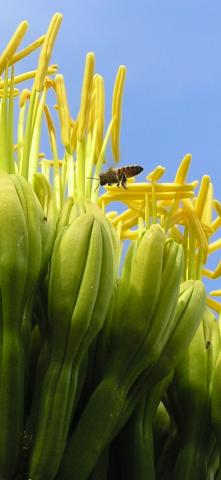
It is not definitely known what triggers Agave flowering. For mature agaves, current thought indicates flowering follows a wet year. Flowering is timed to coincide with the native species’ natural rain cycles and assumes sufficient moisture for seeds to germinate. (Bees pollinating A. havardiana.)
Flowers of the agave are pollinated by bats, hummingbirds, other nectar eating birds, bees, moths and other insects. The flowers are amass with activity, day and night. Nectar tubes contain one to two tablespoons of sweet nectar, especially in the paniculate species. If pollinated, the capsules turn woody and split, sending numerous flat, black seeds scattering. Seeds will readily sprout with available moisture. Many agaves also reproduce by offsets or pups, but not all.
Most agave can be found growing in arid regions on rocky hillsides and slopes, graveled plains, and in limestone and sand from sea level to over 9000 feet in
elevation. Some agaves are native to areas of greater moisture where they grow on rocky slopes, in oak woodlands, and a few in mixed tropical and temperate forests in thin soil. Agaves like sunny locations and will grow well with partial shade, especially afternoon shade. In a native setting, you'll often find agaves growing under the shade of a tree or another plant. Soil with good to excellent drainage and low organic matter is needed, or as it is sometimes referred to, mineralized soil. Heavy clay soil needs to be very well amended with inorganic amendments for increased drainage. Inorganic amendments are greensand, lava sand, expanded shale, and granite sand. One technique used to increase drainage is to mound the plant, that is, build up a mound of gritty soil to insure good drainage. I've see rather humpy beds of agaves in rainy locations. (A. palmeri at left.) (Photo at right is an example of hilling up SW natives that need better drainage, taken at Peckerwood Gardens.)
The soil mix does make a difference. You can't go wrong with gritty, sandy, calcareous soils. Although most agaves are grown in areas with alkaline soil, they respond better in growth and appearance with rain water or dechlorinated tap water acidified with white vinegar or citric acid to approximate rainwater, a pH of 5.6 (1 tablespoon vinegar to 5 gallons tap water, “Watering Systems for Success in Growing Plants Using Low pH and Ammonium Nitrogen”, Roberts and Burleigh).
Expect differences in the leaves and even shape of the plants depending on your climate, as well as your soil. Factors affecting their appearance include cooler climates than their native habitat, cultivation practices, moisture, soil composition and chemistry, and pot culture. The agaves may not even flower, particularly those agaves grown in conservatories and in containers. An absence of pollinators specific to the agave may prevent flowers from producing viable seeds, if they do flower. This variation in location and culture has lead to a bit of confusion in naming varieties and even species, over the decades. Some species will cross pollinate in the wild, such as the A. parryi species.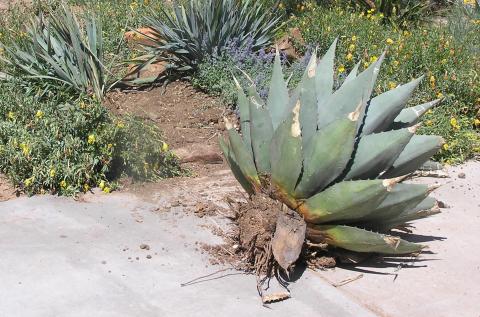
Agaves can be watered frequently during the summer or not. The Texas Panhandle usually receives ample summer moisture for normal agave growth without supplementation, but it won't hurt agaves to be watered weekly, provided the soil drains well.
Moving agaves is not problem. Prepare your new agave hole, insuring good drainage. With a fork or spade dig around the circumference of the agave and down 6-12 inches to remove a good portion of the stem. Replant in the new hole and backfill. Some texts recommending letting the roots dry out before replanting, but in most cases, this is not necessary. Bare root agaves will likewise be just fine when allowed to spend days, weeks, or even months lying on top of the ground in shade before replanting. (A. havardiana on the sidewalk waiting to be replanted.)
Agaves do grow in elevations and on slopes that are subject to occasional light snowfall. Snow is usually light, and melts quickly, running down slopes. The most important factor to remember in wintering over cold hardy agaves outside is to keep them dry. That is, NO winter watering. Heavy snows may cause root rot. In climates colder than their natural habitat, it may be necessary to build up the soil in mounds with the agaves planted on the top to aid in drainage. Good to excellent drainage is key to overcoming winter moisture in climates within the agave’s cold tolerances.
If leaves or other plant parts fall into the agave rosette, they should be cleaned out periodically to prevent rotting, especially after the leaves fall before winter. Avoid locating agaves where snow will be piled up on them.
In addition to being an exceptional ornamental plant of our gardens and containers, agave are sources of food and fiber. Agave americana, A. angustifolia, A. deserti, A. fourcroydes, A. havardiana, A. ocahui (native word for cord or fiber), A. palmeri, A. pelona, A. utahensis, A. sisalana and some of the agaves used for fiber. Agave lechuguilla, A. schottii, A. vilmoriniana were used for fiber, brushes and/or soap. (A. lechugilla at left, from Big Bend National Park.)
Whether roasted and eaten, the liquid extracted as juice or a sweetener or alcoholic beverage, agaves have been used for centuries, and continue to be used. Some of the more common products are Tequila, made from A. tequilana, mezcal, pulque and the blue agave sweetener from other agave species. Agaves used for food or drink, both past and present, include A. angustifolia (mezcal), A. cerulata, A. colorata, A. deserti, A. gigantensis, A. karwinskii, A. marmorata, A. murpheyi, A. neomexicana, A. palmeri, A. parryi, A. pelona, A. polianthiflora, A. potatorum, A. salmiana, A. sobria, A. subsimplex, A. utahensis, A. zebra, and A. tequilana.
Animals use agave pollen and nectar, and for shelter, particularly agaves large enough to hide under. Soft immature leaves will be eaten by wildlife, as well as fruit and seeds that fall to the ground.
Mezcal and Tequila
Both tequila and mezcal can be made from the same agaves, the process differs for the two beverages, however today, mezcal is made mainly from A. angustifolia, and tequila from A. tequilana, two very similar agaves. Usually after 7-12 years, the plants are mature and begin to send up a flower stalk. The flower stalk is cut off to concentrate the sugar content of the harvestable stem, called a piña. The leaves and root are cut off. Mescal is the age old method where the piñas are roasted in a wood-fired oven. A wood fire is started at the bottom of the pit and the piñas are placed on top. The pit is sealed with a tarp, then soil, and the piñas roast for 3-5 days, which gives mezcal its smoky flavor. For tequila, the piñas are cooked in a different manner. After roasting, for both mezcal and tequila, the piñas are pulverized before fermentation, distillations and finishing.
The first permit to produce mezcal was issued by the King of Spain in 1795 to Jose Maria Guadalupe de Cuervo for a product called “Vino Mezcal de Tequila” translated, “Mezcal Wine from Tequila”, the nearby town. Tequila was called tequila, rather can mezcal out of simplicity. Today, the Mexican government regulates both mezcal and tequila production. Tequila can only be made from Jalisco and four neighboring Mexican states.
Agaves that may be marginally cold hardy in your area will benefit from sharp drainage in an area where winter snow won’t persist. Avoid cold wet soil for best results. Agaves can also be covered during blizzards and periods of deeper cold. If unsure whether an agave that should be cold hardy to 0 - 10° will winter over, just try it, amending the soil for good drainage. Until more gardeners try many of these agaves, we won't fully know the extent of their cold hardiness.
Agave cerulata. Medium sized agave that reaches 10-20 inches tall at maturity. Usually yellow-green leaves 10-20 inches long, and 1.5-3 inches wide, variable teeth along the margins, ending with a terminal spine 1-2 inches long. Bud imprint. Leaf color varies among the different varieties. Leaves will also grow wider and rosette will be more open with more watering in this very drought tolerant species. Native to Mexico and Baja California; is the most numerous agave in Mexico. Cold hardy to 10°.
Agave havardiana, Harvard’s agave. A medium size species 24-36 inches tall and wide that forms a tight symmetrical rosette. Upright leaves are a glaucous blue-gray to gray-green, very thick at the base, 6-8 inches wide and up to 2 feet long. Bud imprints on leaves. Teeth are spaced 1-2 inches apart and sharp, and a sharp terminal spine. The inflorescence is a panicle 6 – 16 feet tall, yellow flowers on 15-22 branches. Native to western Texas, southeastern New Mexico south into Mexico in elevations from 4000 – 6500 feet. Few offsets, and typically only when flowering. Cold hardy to -10°. Photo at right.
A. lechuguilla, Shin dagger, Lechuguilla, meaning “little lettuce”. This agave is the indicator plant of the Chihuahuan Desert. A small agave growing to 10-18 inches tall and 16-27 inches wide with few leaves and many offsets. Leaves are 1 – 1 ½ inch wide and 10 – 18 inches tall, light green to yellow green, and strongly striated with yellow or pale green, straight and often curved ending in a sharp terminal spine. Teeth are widely spaced. The inflorescence is a spike that rises 8-16 feet with yellow flowers, shaded red, sometimes purple. Blooms after 3 – 20 years. Native throughout the Chihuahuan Desert region (including Texas, New Mexico and Arizona) forming large colonies. Said to self pollinate. 0° or colder. Photo at left.
A. lophantha, cultivated varieties “Splendida’ or “Quadricolor”. Medium sized cultivated varieties with an open, spreading appearance growing to 20-40 inches tall and 12-24 inches wide. ‘Splendida’ has dark green leaves with a light greenish-yellow vertical stripe on the topside, and a much wider band on the back side. “Quadricolor” has a fairly wide yellow margin and a light green band down the center (top side of leaf only) of the medium green leaf. Bud imprints. Native species A. lophantha can be found in the Rio Grande Valley of Texas and Mexico and into the Mexican state of Veracruz up to 5000 feet. Also makes a great container plant. These also make splendid container plants. Photo of A. lophantha 'Splendida' at right.
A. montana, Mountain Agave. A medium to large size agave grows to 3-4 feet tall and 4-5 feet wide. Apple green leaves that are wide and lined with fierce teeth and striking sawtooth bud imprint. Teeth and spine are reddish. Native to Mexico and grows in elevations up to 9000 feet. Very adaptable to hot dry weather as well as cold; cold hardy to 10°.
A. murpheyi, Murphey’s agave. A medium sized agave grows 3 feet tall and wide. Blue-green to gray-green lanceolate leaves are 2.5 – 3 inches wide and 20-25 inches long with small brown teeth along the margin and a short terminal spine. Pale crossbands and bud imprinting. The inflorescence is a panicle 10-13 feet tall with waxy green to yellow flowers. The stalk begins to grow in winter, and suspends growth during coldest period, then resumes growing. Flowers in early spring. Propagation is usually by offsets or pups. Native to central and southern Arizona into Mexico. Cold hardy to 10°.
A. neomexicana, Mezcal, Mezcal, meaning oven-cooked agave. Small to medium agave whose rosettes average 10-16 inches tall and 12-27 inches wide, with numerous offsets. Blue-green glaucous leaves grow to 2-5 inches wide and 8-18 inches long with teeth along the margin and rounded terminal spine. The inflorescence is a panicle 8-11 feet tall, with 10-17 branches on the upper half of the mast. Flowers are red in bud and yellow when open, blooming in late spring. It’s native range is southeastern New Mexico and western Texas. Cold hardy to -20°. Photo at right.
Agave nickelsiae, formerly A. victoria-reginae ‘King Ferdinand’. Small to medium in size, the King Ferdinand agave is a dense, symmetrical rosette of hard triangular leaves marked with white, that is larger and chunkier than the Victoria agave. Caliche soil intensifies the white markings; markings will disappear in soil that is not alkaline. The flower is a dense spike rising 10-13 feet tall with cream colored flowers, tinged with red or purple. Native to Coahuila area of Mexico. Cold hardy to at least 10°, possibly lower with sharp drainage. Should winter over in a protected location. Photo at left.
A. palmeri, Palmer’s agave. A medium sized agave 3 -4 feet tall and 1 ½ – 4 feet wide that is usually solitary with few offsets. Pale glaucous green lanceolate and rigid leaves are guttered all the way along, with teeth along the margins and ends with a thin, needle-like spine 1-2 inches. The inflorescence is a panicle 10-16 feet tall with 8-12 branches that angle first out, then upwards. Native to southeastern Arizona, southwestern New Mexico and into northern Mexico. In elevations 3000 – 6000 feet. Cold hardy to 10°.
A. parryi neomexicana One of the smaller selections of A. parryi with smaller, more narrow leaves. This variety grows to about 1 1/2' tall x 2' wide, with many offsets. A. parryi neomexicana is native to southeastern New Mexico and west Texas, growing on rocky limestone slopes from 1400 to 7000 feet in elevation. Inflorescence is a panicle. Cold hardy to -20°. Photo at right.
A. parryi var. parryi ‘Estrella Mountains’. A cultivated (tissue culture from Mountain States Wholesale Nsursery)) variety of A. parryi, rarely setting offsets. Medium in size, 2-3 feet tall and wide with blue green leaves, teeth and a terminal spine. Inflorescence is a panicle. Cold hardy to -20°. Estrella Mountains is a mountain range that borders Phoenix, AZ.
A. parviflora, Smallflower Century flower. The smallest of the agaves grows only 4-6 inches tall and 6-8 inches wide. Dark green leaves are 2-4 inches long and less than a half inch wide with short white filaments along the edge and tiny teeth at the base of the leaf and a short, weak terminal spine. This narrow leaf will show a bud imprint. The inflorescence is a spike 3-6 inches tall with pale yellow flowers in mid summer. This species dies after flowering, will the leaves remain green for up to two years after flowering. Native to a limited area of extreme southern Arizona and into Mexico at Chihuahua. Difficult to distinguish from A. polianthiflora until it flowers. Cold hardy to 10°. Photo at right is A. polianthiflora, which is quite similar to A. parviflora.
Agave polianthiflora,Tuberose-flowered Hardy Century Plant. A one of the smallest agaves with non-offsetting rosettes to only 5" tall x 10" wide, composed of short dark-green leaves .25 - .50 inches wide and 4 – 8 inches long highlighted with an abundance of white filaments and minute teeth. Bud imprints! Inflorescence is a spike 4-6 feet tall with rose-red flowers in the middle of the stalk, similar to a tuberose. Native to the Sonora-Chihuahua border in Mexico from 4000 – 6000 ft. Easily distinguished from A. parviflora, only by its flower. Cold hardy to 10°. Photo at right in container has 2 Agave polianthifloras to the right and left, the agave in the center is A. filifera schidigera.
A. salmiana, Giant agave, Pulque Agave. A very large species grows 5-6 ½ feet and 10-13 feet wide. Wide dark green to glaucous gray-green leaves are thick, smooth and hard and grow 10-14 inches wide and 3 – 6 1.2 feet tall. The leaves are guttered and fold at the tip, teeth along the margins with a long terminal spine of 2-4 inches. Flower is a a very tall inflorescence about 25 feet with yellow flowers tinged in red when in bud. Agave salmiana var. ferox is an urn-shaped variety and is the common agave grown in European gardens. Native to central Mexico. Cold hardy to 5°.
A. schottii, Schotts agave, shin dagger, Amole, Amolillo. A small agave that grows to about 12 inches tall and wide. Linear yellow green leaves are smooth and thin, about a quarter inch wide and 10-16 inches tall with coarse filaments along the margin, no teeth and a short, fine terminal spine. The inflorescence is a spike 5-8 feet tall. Native to southern Arizona and southwestern New Mexico into Mexico and found above 3000 feet. Cold hardy to 10°.
A. scabra. Rough Agave. Agave scabra is a medium- to large-sized plant that grows 3 to 5 feet tall and wide, with relatively few recurved leaves that form an elegant urn shape at maturity when given enough space. Its gray-green leaves are strongly curved with heavy teeth and substantial terminal spine. The leaves have a characteristic roughness, a rarity among agaves, that lends its common name. Bud imprint. Inflorescence is a panicle 13-19 feet tall with 8 – 12 branches with yellow flowers between April to June. Takes approximately 18 years before blooming. It grows on sandy and calcareous soils in the southwestern Rio Grande Plains and into northern Mexico in the Chihuahuan Desert. Will rot in cool moist conditions. Said to be cold hardy to 10°, but has wintered over for five+ years. Photo at left.
A. toumeyana. Another quite small agave growing no more than 12 inches wide and with many leaves, 40-70. Green leaves are half inch to three quarter inch wide and 8-12 inches long with white filaments along the margin, sometimes with minute teeth. Bud imprint on both sides of leaves. A. toumeyana ssp. bella, is a very small subspecies but with many more leaves, up to 100. the inflorescence is a spike 5-8 feet tall with pale yellow to greenish flowers in mid summer. Native only to central Arizona between 2000 – 4500 feet. Cold hardy to USDA Zone 5 according to one source.
A. utahensis var. eborispina, (synonym Agave utahensis var. nevadensis) A small agave species. Gray green leaves are 6-12 inches long and a half inch to inch wide, teeth at the margin with a very long white terminal spine, 6 inches in length. Flowers in the winter to spring. The most northern of agaves in North America. Native range is in California border near Nevada, near Las Vegas. All the A. utahensis' agaves should be cold hardy for the Texas Panhandle. Cold hardy 0 – 10°.
A. utahensis var. utahensis. Utah agave. A small clumping agave species growing to 12” tall x 16” wide. Gray green leaves are a half inch to 1 1/4 inch wide and 6-12 inches long ending with a long gray terminal spine ¾- 1 ½ inch long. The inflorescence can be either a spike, raceme or panicle., 5-8 feet tall with light yellow flowers opening in May or June. Grows in northwestern Arizona, Utah, Nevada and California. Cold hardy to 0°.
A. victoria-reginae, and A. victoria-reginae ‘Compacta’, Queen Victoria Agave, and Compact Queen Victoria Agave. A small agave and a more compact form of A. victoria-reginae. Very tight and dense rosette of hard, triangular leaves marked with white, usually up to 12 inches tall, and 18-20 inches wide, rarely with offsets. Dark green leaves are 1 ½ – 2 ½ inches wide and 6-8 inches tall with variable white markings on the surface that form a triangle, then merge into a single line that line up to the terminal spine. No teeth along the margins. The inflorescence is a dense spike 10-13 feet tall with cream colored flowers tinged with red or purple on the upper portion of the mast. A. victoria-reginae is native to arid lower elevations of the Sierra Madre Oriental Mountains in the states of Coahuila, Durango and Nuevo Leon in Mexico and has a Protected Species status. The Queen Victoria agave is one of the most beautiful and most loved agaves. Looks terrific in mass plantings and containers. Cold hardy to 10° or perhaps colder. It has been wintered over in Amarillo with some leaf freezing in my garden for several years.
The agaves profiled below are just a few of the agaves that I’ve tended in containers. They are incredibly easy to care for as container plants and make great focal points. If one can’t find them locally, HighCountryGardens.com, Plant Delights Nursery, Yucca Do Nursery are a few places I’ve ordered from in the past. Any agave is suitable for container growing. Those that are not cold hardy need to be wintered over in a protected place to prevent frost and freezing. The soil mix should be coarse, gritty, low in organic content and drain well. Container agaves could be watered weekly during the growing season. (A. lophantha at left in container.)
After a few years, the agave will outgrow its container. Separate any pups into small containers, and replant the main plant into a larger pot. Some species will offset so much they nearly spill out of the pot if not repotted, others will just sit there with a very large entwined root ball. Sometimes leaves are damaged from moving in and out fall and winter or from hail. Leaves damaged by moving can be trimmed at the stem. Hail damaged plants may take many years to regrow and replace the pitted, damaged leaves. Re-potting and pruning roots stimulates new leaf root growth. Once the root ball is trimmed and repotted with fresh soil mix, it’ll really start to grow again.
Agave americana, Century Plant, Maguey. This is the type species Linnaeus used in describing the agave genus in 1753. Grows very large to 6-10 feet tall and up to 13 ft. wide, with numerous offsets. Blue-gray leaves are 6-10 inches wide and 3- 6 1/5 feet long, smooth, hard, nearly rigid, with a deep curve as it nears the tip causing the leaves to recurve, ending in a terminal spine. Bud imprints on front and back of the leaves. The margins are lined with dark brown to black down curved spines. Colors can vary from gray to blue-gray to green with many variegated varieties (see some below). Inflorescence is a panicle rising to 16-26 feet above the plant with many branches, 15-35 along the upper third of the stalk. Blooms June to August with yellow flowers in nature at around the age of 10, but up to 35+ years in cool climates. Native to Mexico, however, the plant has been in cultivation for so long, the exact area is unknown. Has been used ornamentally around the world since the sixteenth century. Said to be cold hardy to 15°. Makes a great container plant, which will not grow as large is when planted in the ground. Will probably not bloom in a container, or only after very many years. Photo at left is a young A. americana, 3-5 years old.
Agave americana 'Variegata', Variegated Century Plant. Large size agave grows as tall as the above species, A. americana: 6-10 feet tall and up to 13 ft. wide. Thick leaves are held upright, gray-green with thin yellow to white stripes along the leaf margins.
Agave americana var. marginata, Variegated Century Plant. Another large Agave americana variety with broad leaves that arch and curl (sometimes a little wildly) with a green central band and yellow to white stripes along the leaf margins. Although the leaves are more flexible than some, they don’t have much give before snapping.
Agave americana var. medio picta, Variegated Century Plant. Some consider this variety to be the most desirable. Leaves are upright on this medium sized Agave americana variety with wide yellow central variegation. Imprints are light imprinted. Variegation striping can vary from plant to plant. There is also an ‘Alba’, white, version of the medio picta variety. Container plant did not freeze entirely after being left out last winter.
A. desmettiana ‘Variegata’, Variegated smooth agave. Small to medium size 24-36 inches tall with an urn shape. Light green fleshy, thick and smooth succulent leaves edged in yellow that usually lack teeth and ends in a terminal spine. Lower leaf shows bud imprints. The inflorescence is a panicle rising 8-10 feet with 20-25 branches with pale yellow flowers. Usually flowers when the plant has been in ground 8-10 years. There are no known populations of this A. desmettiana today, but probably originates in Mexico. Can be grown in full shade. A terrific agave for containers -- no teeth or spine. Cold damage just below freezing, so bring inside. Photo at left.
A Natural History of the Sonoran Desert, Arizona-Sonora Desert Museum, Arizona-Sonora Desert Museum Press, 2000.
“Agave utahensis, Jewel of the Genus”, Zlatko Janeba, Cactus and Succulent Journal, November-December, 2008.
“Production of Artisanal Mezcal, Tequila’s Sassy Little Sister,” by Dan Mahr, Cactus and Succulent Journal, January-February, 2015.
“Watering systems for Success in Growing Plants Using Low pH and Ammonium Nitrogen”, Elton Roberts and Malcolm Burleigh, Cactus and Succulent Journal, Nov.-Dec. 2010.
High Country Gardens catalog and website.
Mary and Gary Irish, Agaves, Yuccas and Related Plants, Timber Press, 2000.
Mountain States Wholesale Nursery catalog and website.
Native Plants for Southwestern Landscapes, Judy Mielke, University of Texas Press, 1993.
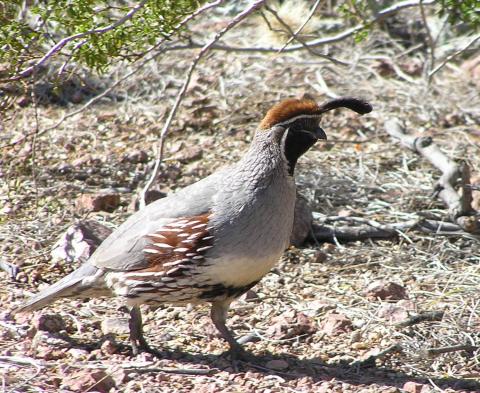
Photo at left is A. vilmoriniana, a large agave.
Angie Hanna, August, 2016